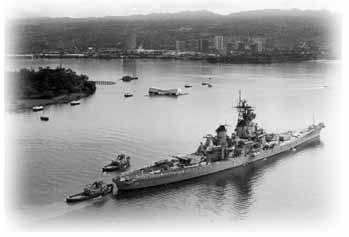Vietnam Service
of the Seventh Fleet, 1962-1973
Few Americans recognize that from the time that United
States' assistance to the Republic of South Vietnam was
confined to an advisory status through the period of major
combat actions, the varied and extensive roles of the U.S.
Navy Seventh Fleet were crucial to the overall military
effort in Southeast Asia.
Mobility and the endurance sustained by underway
replenishment forces resulted in maximum use of Seventh
Fleet carriers for retaliatory raids, for strikes in
support of troops ashore, and for attacks against the enemy
lines of communication.
 USS
Enterprise | Naval air
operations were of particular importance until adequate
airfields could be built ashore. |
In addition, the ability of task forces to operate in
nearby Tonkin Gulf permitted effective and efficient air
operations against targets in North Vietnam.

Battleship New Jersey
Attached to the Seventh Fleet the Battleship New Jersey
fired 3,000 rounds of her 16 inch guns and 7,000 rounds of
her smaller guns into enemy coastal positions in support of
ground troops in Vietnam.
 | Destroyers
and cruisers added the weight of their gunfire
in support of forces ashore, and conducted operations
against the logistic lines of the enemy along the coast of
North Vietnam. |
After early participation by the U.S. Seventh Fleet in the
detection of infiltration by sea from the north, a Coastal
Surveillance Force, (TF115), conducted inshore operations
as well as off shore patrols to augment the efforts of the
Vietnamese Navy.
The Amphibious Force of the Seventh Fleet projected ashore
the U.S. Marines, at Danang in March 1965, and carried out
many later landings.As you will see LST 1159, Tom Green
County served with distinction in several phases of the
Seventh Fleet's Vietnam operations.
 | In addition,
Seal Teams engaged
in guerilla warfare
against the Viet
Cong |  |
The River Patrol Force(TF 117), extended the control of
waterways in the Mekong Delta and other areas of the
Republic. The joint Navy-Army operations of the Mobile
Riverine Force captured base areas and defeated enemy
concentrations.
Elements of the Coastal Surveillance, River Patrol, and
Mobile Riverine Forces were combined to interdict
infiltration routes from Cambodia into the Mekong Delta, to
control vital Delta waterways, and to harrass the enemy in
his base areas.
Essential support to in country forces was
provided by the Service Force's naval support activities
and Seabees. |  |
Sea lines of logistics were a key to the defense of the
northern provinces. The naval medical personnel with the
Marines, in hospitals and in hospital ships, saved lives
and healed the wounded with unprecedented success. Salvage
forces recovered ships in distress and cleared
waterways.
From across the seas came the vast quantity of supplies
required to fight this major war. All but a small
percentage of the tonnage was delivered by ships under the
Navy's Military Sealift Command.
Click the back button to return to the Fifth Cruise.






